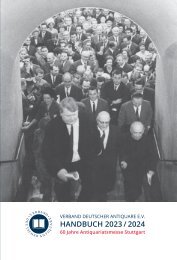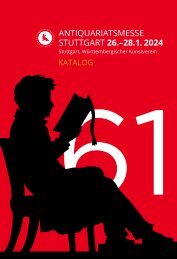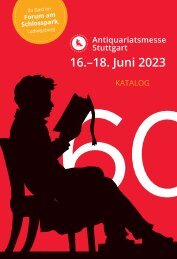Antiquariatsmesse Stuttgart 2021 - Katalog
Katalog zur Antiquariatsmesse Stuttgart 2021: Die Antiquariatsmesse Stuttgart als größtes Schaufenster für wertvolle Objekte des Antiquariats- und Graphikhandels in Deutschland findet in diesem Jahr in ungewohnter Form statt. Da eine Präsenzmesse nicht stattfinden kann, haben sich 76 Kollegen aus Deutschland, Großbritannien, Österreich, Frankreich, der Schweiz, den Niederlanden, den Vereinigten Staaten und aus Australien zusammengefunden, um einen Katalog für die Messe zu erstellen und gleichzeitig ein Angebot für eine virtuelle Messe zusammengetragen. Der Katalog wird am 7. Januar 2021 an interessierte Kunden verschickt, die virtuelle Messe öffnet ihre „digitalen Pforten“ am 29. Januar 2021 um 12.00 Uhr unter www.antiquariatsmesse-stuttgart.de
Katalog zur Antiquariatsmesse Stuttgart 2021: Die Antiquariatsmesse Stuttgart als größtes Schaufenster für wertvolle Objekte des Antiquariats- und Graphikhandels in Deutschland findet in diesem Jahr in ungewohnter Form statt. Da eine Präsenzmesse nicht stattfinden kann, haben sich 76 Kollegen aus Deutschland, Großbritannien, Österreich, Frankreich, der Schweiz, den Niederlanden, den Vereinigten Staaten und aus Australien zusammengefunden, um einen Katalog für die Messe zu erstellen und gleichzeitig ein Angebot für eine virtuelle Messe zusammengetragen.
Der Katalog wird am 7. Januar 2021 an interessierte Kunden verschickt, die virtuelle Messe öffnet ihre „digitalen Pforten“ am 29. Januar 2021 um 12.00 Uhr unter www.antiquariatsmesse-stuttgart.de
Sie wollen auch ein ePaper? Erhöhen Sie die Reichweite Ihrer Titel.
YUMPU macht aus Druck-PDFs automatisch weboptimierte ePaper, die Google liebt.
The most splendid book produced in the Northern Renaissance –
Emperor Maximilian I’s romance project printed on vellum and heightened
with gold and silver.
Theuerdank – Maximilian I. ‚Die geverlicheiten
und einsteils geschichten des loblichen streytparen
und hochberumbten helds und Ritters
Tewrdannckhs‘, edited by Melchior Pfintzing.
„Nürnberg“ [Augsburg]: Johann Schönsperger, 1
March 1517. First edition.
2°, c. 362 × 247 mm. 289 vellum ff. (without the blank
f. P5). Final quire with signature A, containing key
to characters, with correction slips on A5v, A6rv,
A8r. With xylographic title, 118 woodcuts by Leonhard
Beck, Hans Schäufelein, Hans Burgkmair,
etc., all with fine contemporary hand-colouring,
highlighted with gold and silver. Fine, large copy,
no flourishes touched by binder’s knife. Vellum
slightly cockled at lower margin. Binding, slightly
later blind-tooled pigskin over bevelled wooden
boards, sewn on five double-cords, covers tooled
to panel design including roll of Christ, Peter, Paul,
John the Baptist, another roll with putti. With eight
brass bosses, two clasps. € *850 000,–
Conceived by Emperor Maximilian I (1459–1519, Emperor
from 1508), this propagandistic, allegorical work
carefully crafts a literary memorial for the Emperor.
Boasting glorious woodcut illustrations on vellum
with contemporary hand colouring and highlighting
in gold and silver, this extremely rare work is of extraordinary
artistic value.
Inspired by Arthurian romances, the German epic
poem ‚Theuerdank‘ celebrates the heroic deeds of
the knight Theuerdank (Noble Mind), a fictitious
representation of Maximilian. Set within magical Germanic
mountainous scenes dotted with fairy-tale castles,
Theuerdank overcomes many perils to win the
hand of Queen Ernreich. The story was inspired by
Maximilian’s 1477 voyage to Burgundy to claim his
beloved first wife, Mary.
Using allegory to create an adventure that adequately
suited his concern with image and fame, Maximilian,
as Theuerdank, is beset by three vicious enemies from
the Burgundian army, Fürwittig, Unfalo, and Neidelhard.
These characters fear that they will lose their
positions under Theuerdank as ruler and try to kill him
on his journey. Maximilian clearly saw the importance
of typography and illustration in moulding his image
and dynasty, and commissioned an epic narrative that
matched his own sense of heroism.
Maximilian personally controlled every aspect of this
work. Production began in 1505 with a large team of
writers and artists and by 1512, a large part of the text
was written. Private secretary Melchior Pfintzing managed
the text’s editing and completion, while Augsburg
humanist Konrad Peutinger negotiated for printing
and supervised the illustration and typographical layout.
The Emperor was known to approve and sometimes
edit some of the 118 woodcut designs, which are
considered the finest series of German Renaissance
book illustration, designed by some of the greatest,
best-known woodcut artists of their time.
These artists sometimes revised their colleagues’ work,
correcting mistakes: Leonhard Beck replaced one illustration
of the crafty Captain Neidelhard with shrubbery,
for example, correcting his placement in a scene
that took place after his execution – Hans Burgkmair’s
error. Clearly, narrative was a central concern to the
makers of this work. Once designed and approved,
the drawings were sent to the shop of Jost de Negker,
who supervised the cutting and accomplished many of
the cuts himself. This was the beginning of a long life
for these woodcuts. Schönsperger re-used the set for
two 1519 editions, and the blocks passed to Heinrich
Steiner for the Theuerdank of 1537. As late as 1693,
these same woodcuts were re-used for an edition
printed at Ulm.
The specially-designed calligraphic type, a fraktur with
forms derived from the Imperial chancellery script
and embellished with flourishes, is called the ‚Theuerdankschrift‘
and is attributed to Vinzenz Rockner, the
Emperor’s court secretary. Even parts of the paper
stock were specially produced for this edition, as the
watermark with the arms of Austria and Burgundy
suggests.
Privately printed by the Imperial court printer Johann
Schönsperger in 300 paper and 40 parchment copies
(only a few of which are coloured), ‚Theuerdank‘ was
never intended to be sold. Maximilian instead meant
to send the vellum exemplars to the sovereigns of the
German realm, which are thus referred to as ‚Princes‘
editions’. In March 1526, the Archduke Ferdinand
distributed copies to certain German subjects as memorials
of Maximilian while retaining an entire chest
of them for himself.
Our exceptional vellum ‚Princes‘ edition’ is a first
edition dated 1 March 1517. It is further enhanced
by outstanding illumination in intense colours with
highlights in liquid gold and silver. Each character is
easily recognisable in prominent colours, and Theuerdank,
when not wearing his armour, is dressed in a
dark violet.
The provenance includes a four-line, German ownership
inscription in ink on the title page, dated 1691. The
book also belonged to St. Florian Monastery, Austria,
according to the armorial library stamp on title-page.
Afterwards, a stamp on pastedown reading „Zentralstelle
für Denkmalschutz im Bundesministerium für
Unterricht“, used in 1934–1938 by the cultural heritage
authority in Austria upon approval of an object’s exportation,
shows its presence there. – Full description
on request.
98






